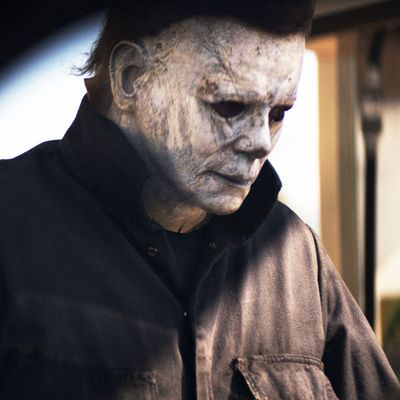
Is there a less intimidating name for a supervillain than The Shape? Since 1978 that term has struck fear into the hearts of horror fans and babysitters alike, but just as an abstract concept, calling someone The Shape is only slightly more bone-rattling then calling them The Blanket. And therein lies the power of the Michael Myers mask from Halloween, which somehow has lived for 40 years as the enduring image of the big bad Boogeyman — despite being a floppy white costume face.
“It’s rooted in something raw, primal, and not supernatural,” says director David Gordon Green. “It’s not cute, and it’s not an even characteristically horrific. It’s not Freddy Krueger’s face and knife gloves, hockey masks and chainsaws. It’s a nothing mask and a nothing wardrobe, and you just project evil onto him.” So to make a mask that represented everything and nothing — the soul of evil and also a blank slate for people to draw their deepest fears on — the new Halloween filmmakers brought on a decorated pro in Emmy and Academy Award–winning makeup and effects specialist Christopher Nelson.
Nelson pitched himself for the job to Halloween producer Ryan Turek with a measurable degree of enthusiasm. “I have to do it,” Nelson said, repeating it three more times in his retelling of the interaction. “You have to hire me. You have to get me in touch with whoever I have to talk to. I’ll do it for nothing. I just have to do Halloween. It’s one of my dream projects ever and my favorite film ever.” Fortunately, having a recent Oscar to your name (Nelson is the one responsible for making Suicide Squad an Academy Award winner) is one hell of a way to back up your boundless glee, and the powers that be gave Nelson the job.
In the early stages of production, Nelson and Green toyed with the idea of innovating the mask, maybe taking a few cues from the ultra-eroded version featured in the Rob Zombie reboot from 2007. But that kind of spitballing didn’t last long before everyone agreed that sticking to the basics — keeping things “simple and relentless,” as John Carpenter instructed them — was the best approach. “The form” that fans were showing up expecting to see needed to be preserved. “We have to capture the essence of it, and make the shape scary again. So that’s where it all started,” says Nelson, who emphasized that the mask itself is more a character in its own right than it is a prop. “The essence is the Boogeyman, what we first saw in that blank, emotionless face — there’s no rhyme or reason, and there’s no motivation. There’s no anything other than evil.”
To summon that malevolence again, Nelson and his team used the design of their original mask as their baseline and basically emulated the effects of time. They researched other costume masks that had been aging for decades to study the breakdown patterns, considering every little detail. “How they wrinkled, how they creased, how they degenerated,” says Nelson. “Where has it been? Has it been sitting in the dark and a box? Is it folded up? Has it been handled by greasy, dirty hands?” But the team knew they couldn’t just put together a one-to-one re-creation of a rubber mask that had been sitting in storage 40 years. Something so true to reality wouldn’t have the structural integrity to survive another reckless killing spree, and after all, a semi-immortal like Michael Myers would require a mask with similarly remarkable durability.
While it was not the intended effect, the way Nelson altered the iconic face ended up turning into something like a second skin that had aged along with its wearer — an unplanned result that only heightened his attempt to distill “that face of tragedy in that face of evil.” And in addition to just making it older, Nelson was committed to making something so seemingly static into a dynamic screen presence. “All I tried to do was bring my love of that character into it,” he says. “I went out of my way to make it look different in every shot, changing the padding within the mask just on my own to set it off, changing the way it’s placed on him, changing the paint stains. So it’s constantly evolving and changing like the Boogeyman. I don’t think a lot of people knew that I was doing that.”
Longtime fans will also notice the battle scars lovingly re-created from Michael’s original tussles with Laurie Strode (Jamie Lee Curtis), like a hole in the neck area from where she stabbed him with a knitting needle, and blood around one of the eyes, which would have been left behind after she got him with the coat hanger. Once it was time to shoot, Nelson and the filmmakers had to make sure the mask stayed secret for as long as possible. He would bring the masks to set in a bag and give a glance around the perimeter for nearby cameras before fitting it to the actors. Nelson says people on set joked that he probably slept with the masks to keep them safe at night (he didn’t), but the care paid off, and Michael’s new face didn’t make an appearance until Universal started releasing official stills.
So what does a Halloween obsessive do once he’s entered horror history as the man behind an icon? Does he put it next to his Oscar? “I of course have a coveted Michael Myers mask that lives somewhere that I’m not gonna tell anybody,” says Nelson, who knows he could just make more of them anytime he wanted — but he isn’t about to water down The Shape mask market with hollow reproductions. “It’s in an undisclosed location, and it is mine and I love it.”





